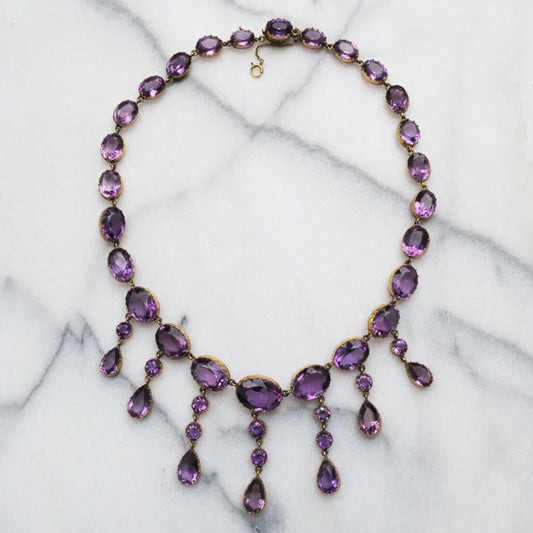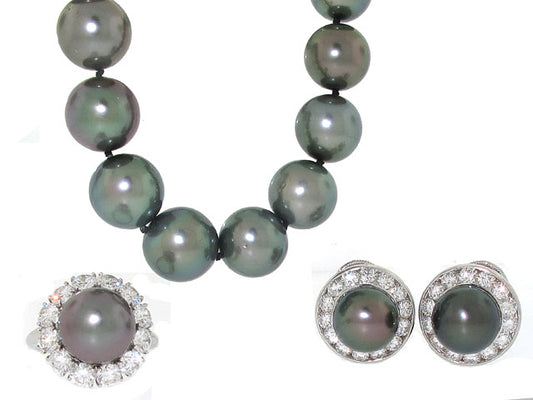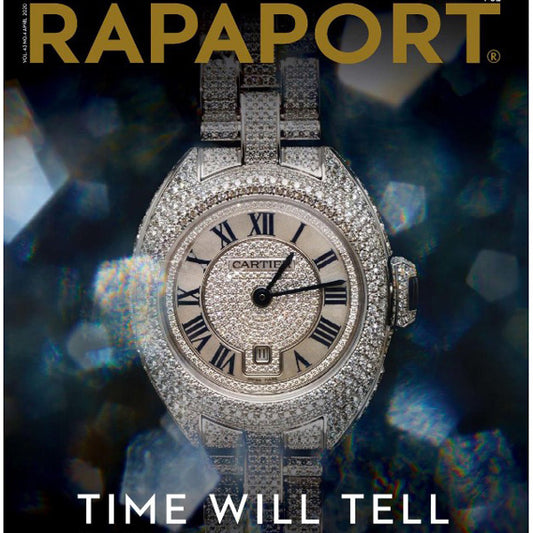The precise meaning of the term “Art Deco” can be confusing as it was not actually used during the historic period it refers to, and it encompasses a wide divergence of styles and influences such as those taken from Asia, Persia, Africa and ancient Egypt. The actual term comes from a 1925 Parisian arts and textiles exposition called the International Exposition des Arts Decoratifs, which displayed modern artwork from throughout the world. However, though the movement’s name derives from the exhibition, the exposition was really a culmination of a number of artistic developments that had taken place beginning at the turn-of-the-century over two decades earlier.
The soft tones used in Art Nouveau jewelry were replaced in Art Deco jewelry with dramatic contrasts of color achieved through couplings of precious and semi-precious stones. In 1910, the Russian Ballet attracted worldwide acclaim, and the ballet’s bold costumes and stage sets designed by Léon Bakst inspired jewelers throughout Europe. Elements from the designs such as their vibrant, bold colors and Eastern themes began turning up in Art Deco jewelry in the form of dramatic rubies and emeralds and jade. Later, the discovery of King Tut’s tomb in the 1920s created an international fervor known as “Egyptomania,” and jewelry designs with ancient Egyptian motifs such as falcons, scarabs and griffins began to appear on jewelry created by artists at the premier jewelry houses. The gemstones found in King Tut’s jewelry such as lapis lazuli, onyx, and carnelian were frequently used in Art Deco jewelry as well. Especially popular was the contrast between diamonds and black onyx, as the period favored monochromatic decorative elements. Accompanying this resurgence of interest in Africa was the use of ivory in Art Deco jewelry. The bold geometric motifs often associated with Art Deco jewelry took from Cubism and the Modernist approach to design — abstract and geometric structuralism.
Art Deco Bracelets
Popular during the Art Deco period were plaque and link bracelets created with bold geometric and linear designs. Many bracelets were made in the all-white look of platinum and diamonds, or with the contrast of brightly colored gems such as rubies, sapphires and emeralds. Art Deco bracelets were often worn on both wrists and in multiples for an ultra glamorous look.
Everything about Art Deco jewelry evokes glamour. In fact, its bold geometric look adorned the necks, wrists and ears of silver screen goddesses in the 1930s.
Art Deco Brooches
Following World War I, the look known as la garconne or flapper, which emphasized bare arms and dropped waistlines, became popular. Replacing the belts and corsages that had been popular in earlier decades, brooches and dress double clips were worn at the waist and in pairs at the shoulders, and small hat ornaments were used to decorate the popular cloche hat or the bandeau.
Art Deco jewelry truly makes a statement and has always been a favorite of jewelry lovers. Art Deco jewelry designs are bold, daring, glamorous, exotic; an Art Deco brooch is all you need to add some sparkle to your look! Double clip diamond brooches are perfect for each strap of a cocktail dress, or clipped to the side of a sweetheart neckline, or our favorite, worn at the base of a low backed gown. Wear an Art Deco brooch in your hair, on a belt, on your jacket or on a scarf. Attach one to a chain for a gorgeous pendant necklace. However you choose to wear your Art Deco brooch, you can’t go wrong with the timeless glamour of the style.
Art Deco Diamond Jewelry
The glamorous effect of the diamonds worn by silver screen bombshells like Jean Harlow have always been in demand among jewelry lovers. While bold colored, exotic jewelry was popular in the 1920s, the note blanche or all-white look of platinum and diamonds first created by Jean Fouquet, became popular in the 1930s and continues to symbolize old Hollywood glamour. In fact, Madonna recently featured platinum and diamond jewelry originally designed by Neil Lane for Mae West, Jean Harlow and Ginger Rogers in her “Hollywood” music video.
During the Art Deco period, technological advances in diamond cutting allowed diamonds to be cut into modern, three-dimensional geometric shapes such as triangles, hexagons and octagons and then placed in domed or stepped mounts. A cutting technique ideal for emerald jewelry, the emerald cut was popular during the period for the clean lines it gave to both emeralds and diamonds. Also popular during the 1930s was the contrast of diamonds with bright stones such as rubies, emeralds, and sapphires, and invisible settings were perfected during this period. The most famous of invisible settings, the Mystery Setting, was developed by the Van Cleef & Arpels design firm whose mastery of the technique made each contemporaneous piece a marvel of innovation. During the Art Deco period, many women stopped piercing their ears so Art Deco earrings are often screw-back. During the 1920s, earrings were often in the shape of long pendants and teardrops to complement the short bobbed hairstyles and long necklaces that were in vogue at the time.
Art Deco Costume Jewelry
The Art Deco period was a time of economic hardship for most people, which resulted in the increased popularity of costume jewelry, a movement championed by Coco Chanel herself. Design was emphasized over intrinsic value; while the value of jewelry in revitalizing an old outfit was used in advertising. New materials were used, such as Bakelite, rhinestones, silver and marcasites for a flashy but affordable look. Glittery marcasites and silver were especially popular as they emulated the platinum and diamond look popularized by old Hollywood.
Following World War I, with the fashion-forward trend known as la garconne, or the Flapper look, the fashion silhouette switched from curvy to vertical. Accompanying this dramatic change in the fashion silhouette was a transition from shorter necklaces to long pendants and tassels and long, dramatic ropes of pearls often associated with the flapper image. The great popularity of long ropes of pearls, which were incredibly valuable in the 1920s, fueled the search for cheaper alternatives such as the cultured pearls invented by the now iconic Kokichi Mikimoto in the 1930s.
Long draping pendants and ropes of pearls have never lost their appeal. Longtime favorites of fashion icons such as Coco Chanel, these necklaces are bold yet classic. Whether it’s an elegant string of pearls or a stunning geometric diamond necklace, Art Deco necklaces are a must have for every elegant woman.
A traditional and elegant addition to any gentleman’s wardrobe is a collection of cufflinks and tuxedo sets. To be worn with button-up shirts, or a tuxedo, cufflinks and studs are a decorative way to add sophistication and sleek style to formal and professional fashions.
Art Deco cufflinks are the consummate juncture between function and fashion. The wonderful symmetry of the design, the opaque color schemes and the streamlined geometry of Art Deco cufflinks creates a style of men’s jewelry which is as in vogue as it is versatile.
Art Deco design rose in conjunction with the “Roaring Twenties”. The streamlined beauty of Art Deco jewelry reflects the exuberance and excitement of the Jazz Age and the rising importance of speed which was being physically represented in the designs of ocean liners, sports cars, locomotives and airplanes. The 1920s were a time for advancement and this was evident in architecture, technology and design on all levels.
With the dramatic changes in women’s costume in the 1920s, particularly the unstructured, low-waist “flapper style” dress accentuating the bare neck and arms, new jewelry styles were created to complement these fashions. Jewelry that moved freely, such as dangle earrings and long pearl or bead necklaces were popular.

Art Deco design can also trace its roots to the trends in Modern art with an emphasis on geometry, symmetry, movement and speed. The flat and sleek line bracelet was an example of this. Linearity and geometric forms were favored while figurative motifs often appeared in a very stylized, or highly abstracted form. Gemstones tended to be cut in geometric shapes keeping with the Deco aesthetic, particularly after advances in gem cutting led to the baguette and emerald cuts. Long strands of beads or pearls, dangle earrings, line bracelets, double clip brooches and jeweled accessories such as evening bags and cigarette cases became fashionable. The Deco Period also brought about the cocktail party, in spite of prohibition, and from it derived the “cocktail ring”.
The Art Deco Period produced many of the finest designs in jewelry and creations from this era remain highly desired by collectors.













